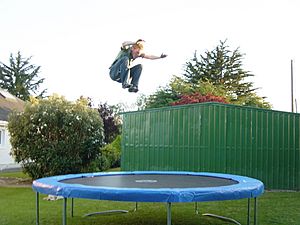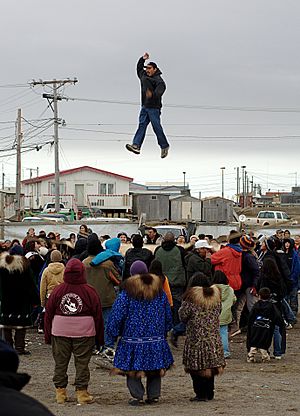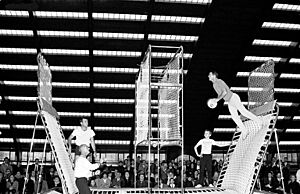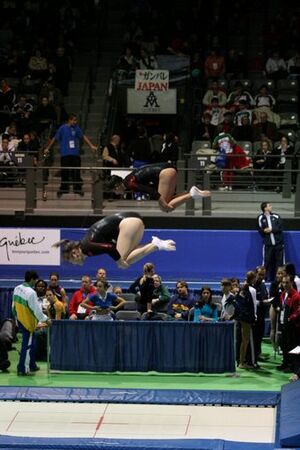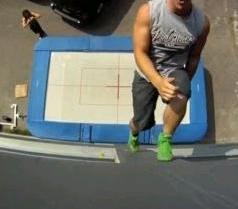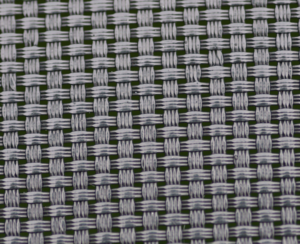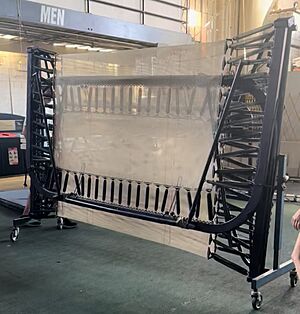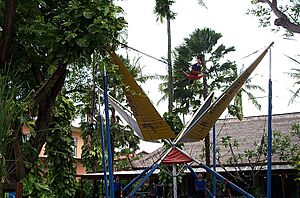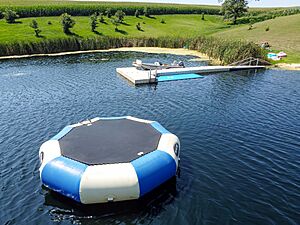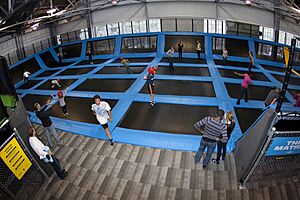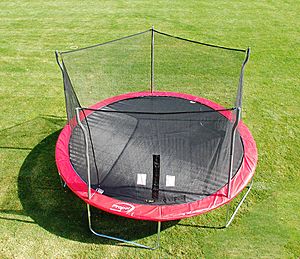Trampoline facts for kids
A trampoline is a bouncy device! It has a tight, strong piece of fabric (called the bouncing mat) stretched over a steel frame. Many springs connect the mat to the frame. People use trampolines for fun and for sports competitions.
The bouncing mat itself doesn't stretch much on its own. Instead, the springs connecting it to the frame make it bouncy. These springs store energy that helps you bounce high!
Contents
The History of Trampolines
Early Bouncing Devices

Long ago, people used devices similar to trampolines. The Inuit people, for example, would toss blanket dancers into the air using a walrus skin. This was part of their spring celebration after a whale harvest.
There are also stories from Europe about people being tossed into the air using a blanket. However, these were often punishments, not for fun. Firefighters even used trampoline-like "life nets" starting in 1887 to catch people jumping from burning buildings.
In the 1800s, some circus shows featured performances on something called a "trampoline." This was probably more like a bouncy board than the springy fabric trampolines we know today.
Early in the 1900s, acrobats sometimes used a "bouncing bed" on stage. This was a small trampoline covered with bedclothes. Acrobats would perform funny acts on it to entertain the audience.
The First Modern Trampolines
The first modern trampoline was built in 1936 by George Nissen and Larry Griswold. They were both gymnasts at the University of Iowa in the United States. They saw trapeze artists using a tight safety net to add excitement to their shows.
Nissen and Griswold decided to try something similar. They stretched a piece of canvas with metal rings (grommets) on its sides to an iron frame using springs. At first, they used it to train tumblers. But soon, people realized how much fun it was on its own!
Nissen said the name "trampoline" came from the Spanish word trampolín, which means a diving board. He heard this word during a trip to Mexico in the late 1930s. He then used an English version of the word as the name for his new bouncing device.
In 1942, Griswold and Nissen started a company to make trampolines. They called their company the Griswold-Nissen Trampoline & Tumbling Company. They began selling trampolines in Cedar Rapids, Iowa.
George Nissen also imagined trampolines being used for games with more than one person. One game he created was Spaceball. This game was played by two teams or two people on one trampoline. It had special "walls" at the ends and a "middle wall." Players would try to hit a target on the other side's end wall with a ball. Spaceball was even used by NASA to train astronauts!
Trampolines for Flight and Astronaut Training
During World War II, the United States Navy Flight School started using trampolines. They helped train pilots and navigators. The trampolines gave them practice in knowing where they were in space, which was very important for flying.
After the war, trampolines were used again to help train both American and Soviet astronauts. This helped them get used to different body positions while in flight.
Competitive Trampoline Sports
The very first Trampoline World Championships were held in London in 1964. The first world champions were Americans Dan Millman and Judy Wills Cline. Judy Wills Cline became one of the most successful trampoline champions ever.
A very important coach in competitive trampolining was Jeff Hennessy from the University of Louisiana at Lafayette. He coached the United States trampoline team and helped many athletes become world champions, including his daughter, Leigh Hennessy. Both Jeff and Leigh Hennessy are in the USA Gymnastics Hall of Fame.
Trampolining became an Olympic Games sport in 2000. On a modern competition trampoline, skilled athletes can bounce up to 10 meters (about 33 feet) high! They perform amazing somersaults and twists in the air. Trampolines are also used in other sports like Slamball, which is like basketball, and Bossaball, which is like volleyball.
Cross-Training for Other Sports
Many other sports use trampolines to help athletes practice their acrobatic skills. Divers, gymnasts, and freestyle skiers use them in training. A big advantage of using a trampoline for training is that athletes can practice acrobatic moves very quickly, every two seconds or less. This is much faster than sports that need hills or high platforms. It can also be safer than landing on the ground.
Wall Running
Wall running is a sport where people use a wall next to the trampoline to do tricks. The basic move is to land on your back on the trampoline, then push off the wall with your feet at the top of your bounce. From there, you can do many acrobatic moves, just like regular trampolining. The wall helps you twist and turn more strongly. You can also gain energy from both the trampoline mat and the wall.
Different Types of Trampolines
Recreational Trampolines
Recreational trampolines are made for home use and are not as strong as competition ones. Their springs are also weaker. They come in different shapes, like circles, octagons, or rectangles. The bouncing mat is usually made of waterproof canvas or woven plastic. Most recreational trampolines use springs, but some "spring-free" trampolines also exist.
Competitive Trampolines
The frame of a competitive trampoline is made of steel. It can fold up for easy transport to competitions. The bouncing mat is a rectangle, about 4.28 meters (14 feet) long and 2.14 meters (7 feet) wide. It fits into a frame that is about 5.05 meters (16.5 feet) long and 2.91 meters (9.5 feet) wide. Around 110 steel springs connect the mat to the frame. The mat is made of a very strong woven fabric.
Bungee Trampolines
Bungee trampolines are popular attractions at fairs, holiday resorts, and summer camps. Some cruise ships and ski resorts also have them. People wear a harness connected to bungee cords. These cords help them bounce much higher than usual. This allows people who are not gymnasts to do flips and other cool moves safely.
Water Trampolines
Water trampolines are inflatable, but their bounciness doesn't come from being filled with air. Like regular trampolines, they have a bouncing mat held by springs. These trampolines let people combine swimming with trampoline fun. They are popular for renting at lakes.
Commercial Trampoline Parks
In the late 1950s and early 1960s, outdoor "jump centers" or "trampoline parks" became very popular in North America. However, many accidents happened, and people quickly lost interest.
In the early 2000s, indoor commercial trampoline parks made a big comeback! Many of these parks opened across the United States and Canada. By 2014, there were at least 345 trampoline parks in the U.S. alone. Similar parks have also opened in other countries. By March 2019, CircusTrix (which owns Sky Zone) was the largest operator, with 319 parks worldwide.
These indoor parks have trampolines that go from wall to wall. This helps stop people from falling off onto hard surfaces. Padded walls or spring walls also protect people from injuries if they hit them. Even with these safety measures, accidents can still happen.
Safety When Using Trampolines
Using a trampoline can be dangerous if you are not careful. Organized clubs and gyms usually have large safety pads at each end. They also have "spotters" who stand by the trampoline to try and catch athletes if they lose control and fall. In 1999, it was estimated that 100,000 people went to the emergency room for trampoline injuries in the U.S.
Most injuries happen on home trampolines or in commercial trampoline parks, not in organized gyms. This is because home trampolines and parks often have fewer safety rules.
In Canada, the trampoline park industry is not strictly regulated. This means different parks might have different safety standards for padding or foam pits. They also do their own safety checks and repairs. They are not required to report injuries. Often, there are not enough staff to make sure everyone follows the rules. Also, advertisements sometimes show people doing somersaults, which can be very dangerous without proper training. Most trampoline parks make people sign waivers. These waivers say that you accept the risk of injury, even if it's because of the park's own mistakes or broken equipment.
Bouncing off a trampoline can lead to a fall of 3 to 4 meters (10 to 13 feet) to the ground. You could also fall into the springs or frame. Some doctors have even suggested that trampolines should not be used at home.
Experts recommend that only one person should jump at a time. This helps avoid crashes and people being thrown in unexpected directions. One of the most common causes of injury is when many people jump on the trampoline at once. This often leads to people bumping into each other and getting hurt. Many people break bones from landing badly after hitting another person.
Another common cause of serious injury is trying to do somersaults without proper training. Sometimes, people land on their neck or head. This can cause paralysis or even death.
You can make trampolines safer by burying them so the mat is closer to the ground. This reduces the distance you could fall. Pads over the springs and frame also help reduce injuries from hitting them. Keeping the springs covered also stops limbs from falling into the gaps.
You can buy safety nets for home trampolines. These nets go around the trampoline to stop users from bouncing off the edge. While nets do prevent jumpers from falling onto the ground, these types of falls are not the most common cause of injury. Many people can still get hurt if they jump together inside a netted trampoline. Safety nets are more helpful for single jumpers, as long as they avoid landing on their head or neck.
Getting some training at a gym can help you learn about possible dangers. It can also teach you how to avoid bad falls.
Family-friendly places like shopping centers or carnivals often have inflatable trampolines for kids. These usually have safety nets on the sides to prevent injuries.
Trampoline Socks
| Other name | Trampolining socks |
|---|---|
| Definition | Socks designed for trampoline use |
| Type | Trampoline protective equipment |
| Core function | Reduction of friction injuries |
Trampoline socks are special socks made for trampoline use. They have rubber on the bottom (the sole) to help your feet stick to the mats. These socks give you better grip on trampolines.
In the past, these socks were mainly used by professional trampolinists to prevent friction injuries. Today, both kids and adults use them.
Trampoline socks have a much better grip than regular socks. They are stretchy and non-slip. They are mostly used in trampoline parks. When you go to a trampoline park, you usually have to wear these special socks. Some companies that make these socks include Urban Air, Gripjoy, Innovate Knitting, and ESA Supplies.
One of the first trampoline socks was shown in May 2026 by Michael Wood, a design student.
Mini-Trampolines
A mini-trampoline is also called a rebounder, trampette, or exercise trampoline. It is a small trampoline, usually less than 1 meter (about 3 feet) across. It sits about 30 centimeters (1 foot) off the ground. People often keep them indoors and use them for physical fitness. This type of exercise, called "rebounding," is gentle on your knees and joints. Mini-trampolines do not let you bounce as high as larger trampolines. Most big stores sell mini-trampolines.
Educational Uses of Trampolines
Science teachers sometimes use trampolines to show how Newton's three laws of motion work. They can also demonstrate an "elastic collision," which is when objects bounce off each other without losing much energy.
See also
 In Spanish: Cama elástica para niños
In Spanish: Cama elástica para niños


